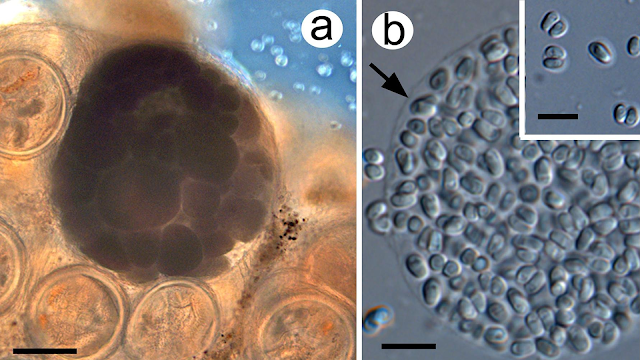Like any living things, parasites can themselves become host to other infectious agents as well, and parasites that specialise in parasitising other parasites are called hyperparasites. The paper we will be looking at today is about some microsporidian parasites that have evolved to parasitise flukes. Microsporidian are a group of single-celled parasites which are somewhat related to fungi, and they infect a wide range of invertebrate animals - including many parasitic animals.
 |
| Left: Fluke metacercaria infected with Unikaryon panopei surrounded with smaller, uninfected flukes Right: Swollen fluke cell, filled with spores. Photos from Fig. 1. of the paper. |
The species featured in this post - Unikaryon panopei - infects flukes which parasitise crabs. More specifically, these flukes were found in black-clawed mud crabs from Tampa Bay, Florida. The researchers who conducted this study collected a relatively small number of crabs - fifteen in total - but that was more than enough to find some which were infected with flukes, because all of them were absolutely loaded, with some crabs harbouring up to 250 fluke larvae.
The fluke's free-swimming larval stages are able to get through the crab's tough exterior with a microscopic, scalpel-like structure called a stylet, which they use to slice their way through the vulnerable parts of the crab's cuticle, such as the leg joints and gill filaments. Once inside, they crawl to the hepatopancreas (also known as the digestive glands), where they curl up and transform into spherical cysts called metacercariae, and wait for the crab to be eaten by a bird. The flukes essentially use the crab as a temporary stopover and transport to get a ride into shorebirds.
At least that was the plan - until Unikaryon came along to completely ruin their lives, and some unlucky flukes found themselves becoming incubators for microsporidian hyperparasites. Fluke larvae which are heavily infected with Unikaryon swells to twice their usual size, and become filled with spores which are packaged in brown ovoid throughout the fluke's body. While in moderately infected flukes, the spores are mostly concentrated in the intestine and the still developing reproductive organs, in heavily-infected flukes, the hyperparasite replaces all of the fluke's internal tissue and organs, turning it a spore-filled husk.
When the researchers examined the evolutionary lineage of U. panopei in relation to other microsporidian parasites, they found that these hyperparasites might have evolved from microsporidians that originally parasitised crustaceans. For whatever reason, over time, they switched to targeting the parasites of said crustaceans instead. In addition to U. panopei, a handful of other Unikaryon species have also been reported from various species of flukes, and even one species from fish tapeworms.
In addition to infecting the metacercariae cyst stages as found in this study, Unikaryon has also been found infecting other life stages of flukes, including the asexual stages in snails, and the free-swiming stages which are produced by infected snails. Yet despite being present in those other life stages, Unikaryon has never been found to infect adult flukes.
Given how Unikaryon has been able to insinuate itself into different parts of the fluke life cycle, while remaining strangely absent in the adult stage, this raises the question of how the flukes even get infected with these hyperparasites in the first place. Do they pick it up from the environment? If so, how - given the fluke stages they infect are situated deep in their host's bodies? How do they get released into the surrounding environment, and how are they transmitted to new hosts? Or is the hyperparasite inherited at birth, and just gets passed down each subsequent generation? If so, how could that be possible since it is absent from the adult stage of the fluke's life cycle?
There are so many questions relating to some of the most basic aspects of this hyperparasite's ecology. Since most groups of parasites are severely under-studied, it is not surprising that we know even less about some parasites' own hyperparasites. These microsporidians are single-celled mysteries, packed in the bodies of animals, which themselves dwell in the armoured bodies of unassuming crustaceans.
Reference:
Sokolova, Y. Y., Overstreet, R. M., Heard, R. W., & Isakova, N. P. (2021). Two new species of Unikaryon (Microsporidia) hyperparasitic in microphallid metacercariae (Digenea) from Florida intertidal crabs. Journal of Invertebrate Pathology, 182, 107582.